Page 55 of 498
337
Safety features of your vehicle
If the child seat moves, readjust the
length of the seat belt. In
Australia/NZ the child restraint man-
ufacturer's instructions must be fol-
lowed when fitting the unit to the
vehicle.Securing a child restraint seat
with “Tether Anchor” system
Child restraint hook holders are
located on the package tray.1.Route the child restraint seat strap
over the seatback.
For vehicles with adjustable head-
rest, route the tether strap under
the headrest and between the
headrest posts, otherwise route
the tether strap over the top of the
seatback.
2.Open the tether anchor cover.
3.Connect the tether strap hook to
the appropriate child restraint hook
holder and tighten to secure the
seat.
OMD030030N
OMD030021N
Page 57 of 498
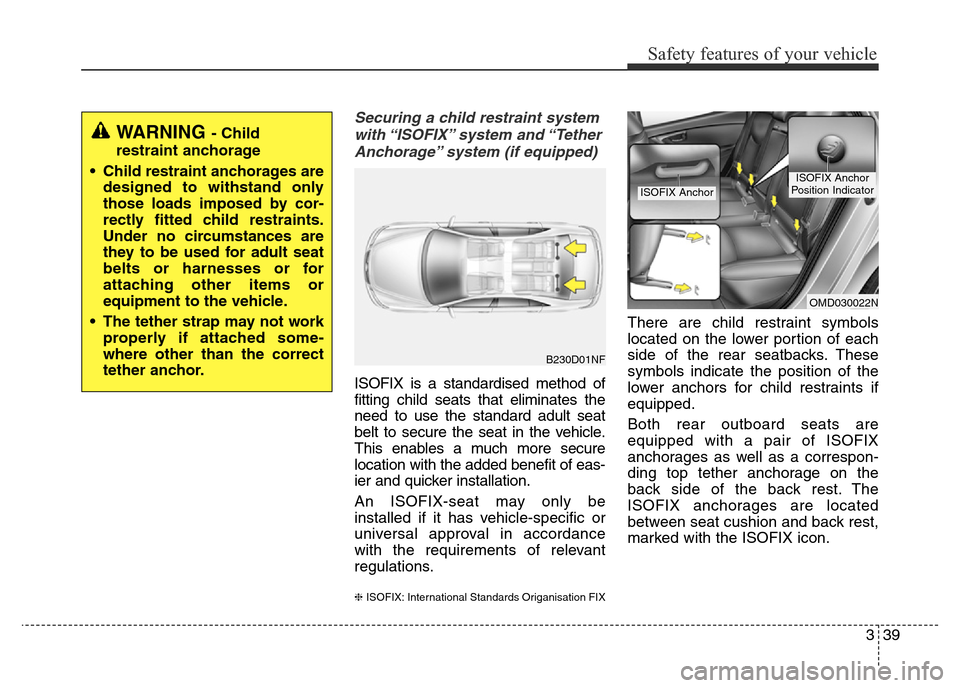
339
Safety features of your vehicle
Securing a child restraint system
with “ISOFIX” system and “Tether
Anchorage” system (if equipped)
ISOFIX is a standardised method of
fitting child seats that eliminates the
need to use the standard adult seat
belt to secure the seat in the vehicle.
This enables a much more secure
location with the added benefit of eas-
ier and quicker installation.
An ISOFIX-seat may only be
installed if it has vehicle-specific or
universal approval in accordance
with the requirements of relevant
regulations.
❈ISOFIX: International Standards Origanisation FIX
There are child restraint symbols
located on the lower portion of each
side of the rear seatbacks. These
symbols indicate the position of the
lower anchors for child restraints if
equipped.
Both rear outboard seats are
equipped with a pair of ISOFIX
anchorages as well as a correspon-
ding top tether anchorage on the
back side of the back rest. The
ISOFIX anchorages are located
between seat cushion and back rest,
marked with the ISOFIX icon.
B230D01NF
OMD030022N
ISOFIX AnchorISOFIX Anchor
Position Indicator
WARNING - Child
restraint anchorage
• Child restraint anchorages are
designed to withstand only
those loads imposed by cor-
rectly fitted child restraints.
Under no circumstances are
they to be used for adult seat
belts or harnesses or for
attaching other items or
equipment to the vehicle.
• The tether strap may not work
properly if attached some-
where other than the correct
tether anchor.
Page 58 of 498
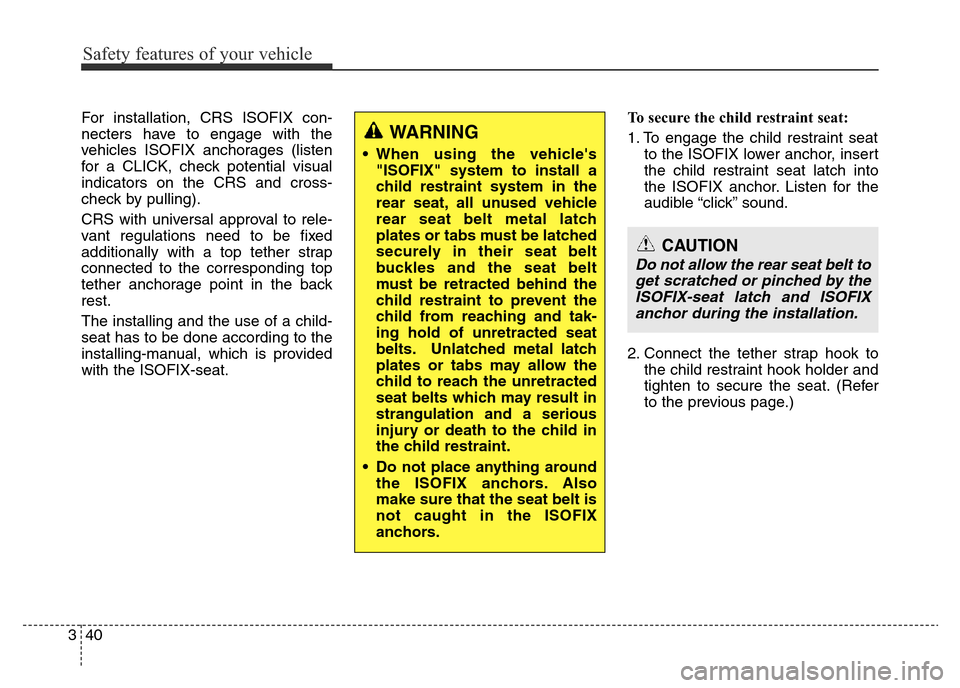
Safety features of your vehicle
40 3
For installation, CRS ISOFIX con-
necters have to engage with the
vehicles ISOFIX anchorages (listen
for a CLICK, check potential visual
indicators on the CRS and cross-
check by pulling).
CRS with universal approval to rele-
vant regulations need to be fixed
additionally with a top tether strap
connected to the corresponding top
tether anchorage point in the back
rest.
The installing and the use of a child-
seat has to be done according to the
installing-manual, which is provided
with the ISOFIX-seat.To secure the child restraint seat:
1. To engage the child restraint seat
to the ISOFIX lower anchor, insert
the child restraint seat latch into
the ISOFIX anchor. Listen for the
audible “click” sound.
2. Connect the tether strap hook to
the child restraint hook holder and
tighten to secure the seat. (Refer
to the previous page.)
WARNING
• When using the vehicle's
"ISOFIX" system to install a
child restraint system in the
rear seat, all unused vehicle
rear seat belt metal latch
plates or tabs must be latched
securely in their seat belt
buckles and the seat belt
must be retracted behind the
child restraint to prevent the
child from reaching and tak-
ing hold of unretracted seat
belts. Unlatched metal latch
plates or tabs may allow the
child to reach the unretracted
seat belts which may result in
strangulation and a serious
injury or death to the child in
the child restraint.
• Do not place anything around
the ISOFIX anchors. Also
make sure that the seat belt is
not caught in the ISOFIX
anchors.
CAUTION
Do not allow the rear seat belt to
get scratched or pinched by the
ISOFIX-seat latch and ISOFIX
anchor during the installation.
Page 60 of 498
Safety features of your vehicle
42 3
(1) Driver’s front air bag*
(2) Passenger’s front air bag*
(3) Side impact air bag*
(4) Curtain air bag*
* : if equipped
AIR BAG - SUPPLEMENTAL RESTRAINT SYSTEM (SRS)
OMD033032R
❈ The actual air bags in the vehicle may differ from the illustration.
WARNING
• Even in vehicles with air bags,
you and your passengers must
always wear the seat belts pro-
vided in order to minimise the
risk and severity of injury in the
event of a collision or rollover.
• SRS and pretensioners contain
explosive chemicals.
If scraping a vehicle without
removing SRS and pretension-
ers from a vehicle, it may cause
fire. Before scraping a vehicle,
we recommend that you con-
tact an authorised HYUNDAI
dealer.
• Keep the SRS parts and
wirings away from water or any
liquid. If the SRS components
are inoperative due to expo-
sure to water or liquids, it may
cause fire or severe injury.
Page 62 of 498
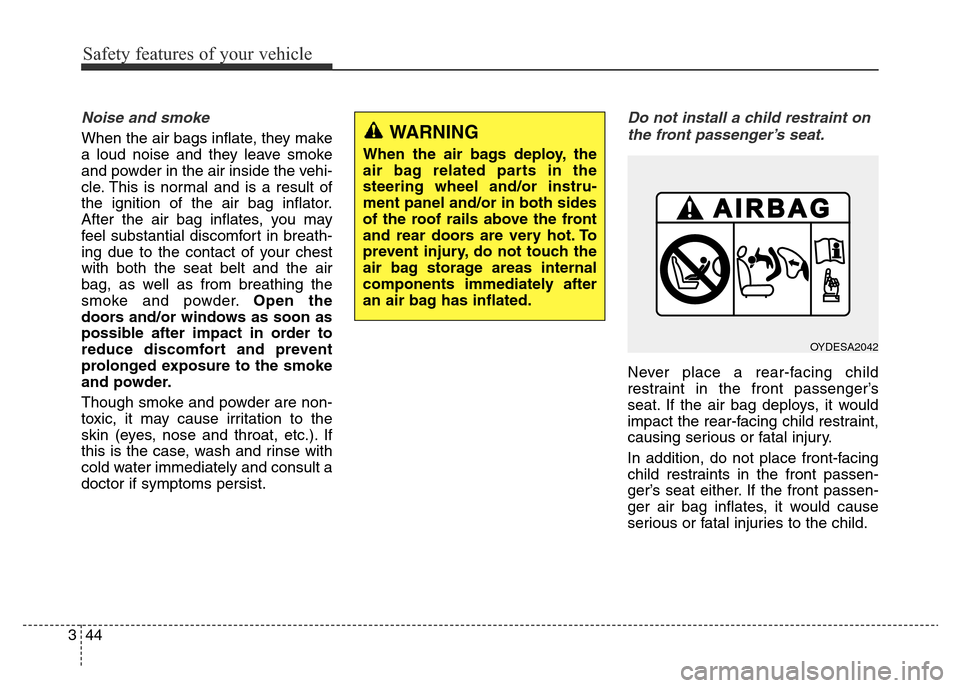
Safety features of your vehicle
44 3
Noise and smoke
When the air bags inflate, they make
a loud noise and they leave smoke
and powder in the air inside the vehi-
cle. This is normal and is a result of
the ignition of the air bag inflator.
After the air bag inflates, you may
feel substantial discomfort in breath-
ing due to the contact of your chest
with both the seat belt and the air
bag, as well as from breathing the
smoke and powder.Open the
doors and/or windows as soon as
possible after impact in order to
reduce discomfort and prevent
prolonged exposure to the smoke
and powder.
Though smoke and powder are non-
toxic, it may cause irritation to the
skin (eyes, nose and throat, etc.). If
this is the case, wash and rinse with
cold water immediately and consult a
doctor if symptoms persist.
Do not install a child restraint on
the front passenger’s seat.
Never place a rear-facing child
restraint in the front passenger’s
seat. If the air bag deploys, it would
impact the rear-facing child restraint,
causing serious or fatal injury.
In addition, do not place front-facing
child restraints in the front passen-
ger’s seat either. If the front passen-
ger air bag inflates, it would cause
serious or fatal injuries to the child.
WARNING
When the air bags deploy, the
air bag related parts in the
steering wheel and/or instru-
ment panel and/or in both sides
of the roof rails above the front
and rear doors are very hot. To
prevent injury, do not touch the
air bag storage areas internal
components immediately after
an air bag has inflated.
OYDESA2042
Page 64 of 498
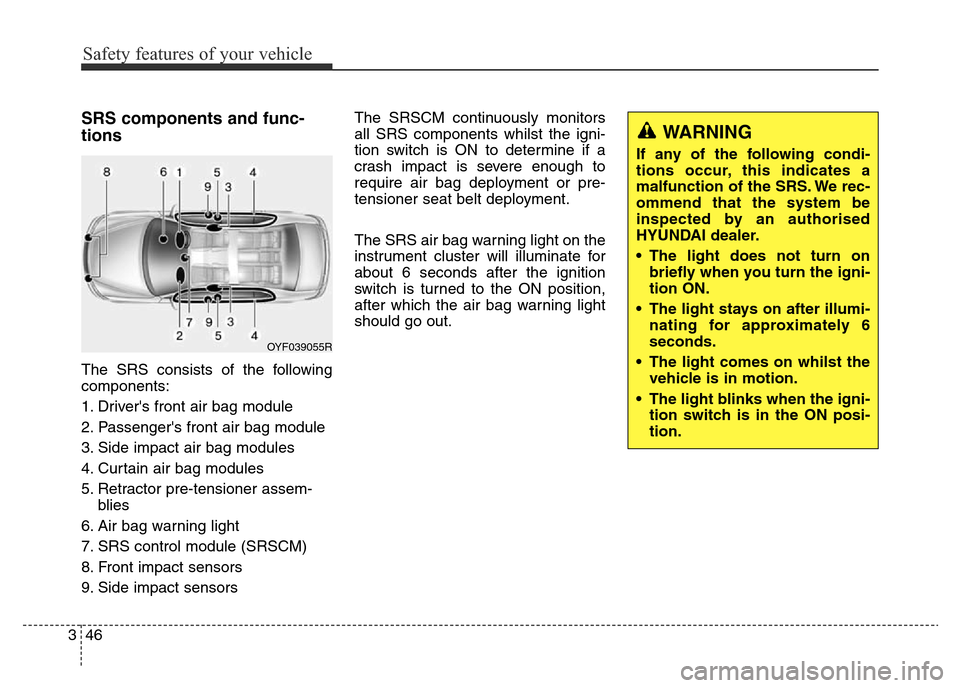
Safety features of your vehicle
46 3
SRS components and func-
tions
The SRS consists of the following
components:
1. Driver's front air bag module
2. Passenger's front air bag module
3. Side impact air bag modules
4. Curtain air bag modules
5. Retractor pre-tensioner assem-
blies
6. Air bag warning light
7. SRS control module (SRSCM)
8. Front impact sensors
9. Side impact sensorsThe SRSCM continuously monitors
all SRS components whilst the igni-
tion switch is ON to determine if a
crash impact is severe enough to
require air bag deployment or pre-
tensioner seat belt deployment.
The SRS air bag warning light on the
instrument cluster will illuminate for
about 6 seconds after the ignition
switch is turned to the ON position,
after which the air bag warning light
should go out.
OYF039055R
WARNING
If any of the following condi-
tions occur, this indicates a
malfunction of the SRS. We rec-
ommend that the system be
inspected by an authorised
HYUNDAI dealer.
• The light does not turn on
briefly when you turn the igni-
tion ON.
• The light stays on after illumi-
nating for approximately 6
seconds.
• The light comes on whilst the
vehicle is in motion.
• The light blinks when the igni-
tion switch is in the ON posi-
tion.
Page 65 of 498
347
Safety features of your vehicle
The air bag modules are located in
the centre of the steering wheel and
in the front passenger's panel above
the glove box. When the SRSCM
detects a sufficiently severe impact
to the front of the vehicle, it will auto-
matically deploy the front air bags.Upon deployment, tear seams mold-
ed directly into the pad covers will
separate under pressure from the
expansion of the air bags. Further
opening of the covers then allows full
inflation of the air bags.A fully inflated air bag, in combina-
tion with a properly worn seat belt,
slows the driver's or the passenger's
forward motion, reducing the risk of
head and chest injury.
After complete inflation, the air bag
immediately starts deflating,
enabling the driver to maintain for-
ward visibility and the ability to steer
or operate other controls.
B240B02L/H
■Driver’s front air bag (2)
B240B01L/H
■Driver’s front air bag (1)
B240B03L/H
■Driver’s front air bag (3)
Page 67 of 498
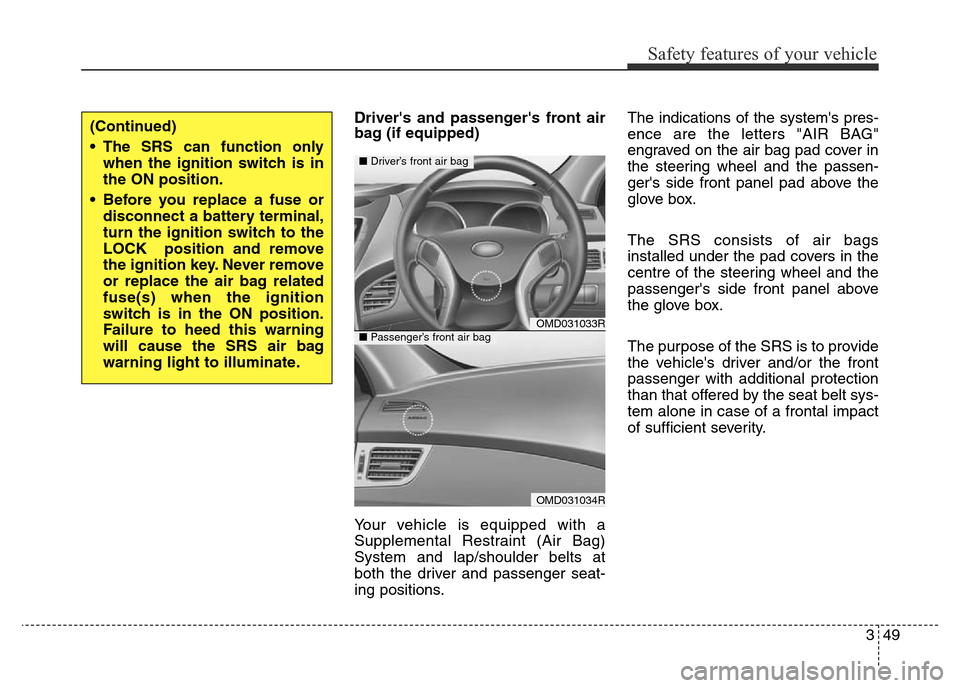
349
Safety features of your vehicle
Driver's and passenger's front air
bag (if equipped)
Your vehicle is equipped with a
Supplemental Restraint (Air Bag)
System and lap/shoulder belts at
both the driver and passenger seat-
ing positions.The indications of the system's pres-
ence are the letters "AIR BAG"
engraved on the air bag pad cover in
the steering wheel and the passen-
ger's side front panel pad above the
glove box.
The SRS consists of air bags
installed under the pad covers in the
centre of the steering wheel and the
passenger's side front panel above
the glove box.
The purpose of the SRS is to provide
the vehicle's driver and/or the front
passenger with additional protection
than that offered by the seat belt sys-
tem alone in case of a frontal impact
of sufficient severity.
OMD031033R
OMD031034R
■Driver’s front air bag
■Passenger’s front air bag
(Continued)
• The SRS can function only
when the ignition switch is in
the ON position.
• Before you replace a fuse or
disconnect a battery terminal,
turn the ignition switch to the
LOCK position and remove
the ignition key. Never remove
or replace the air bag related
fuse(s) when the ignition
switch is in the ON position.
Failure to heed this warning
will cause the SRS air bag
warning light to illuminate.